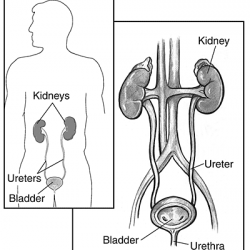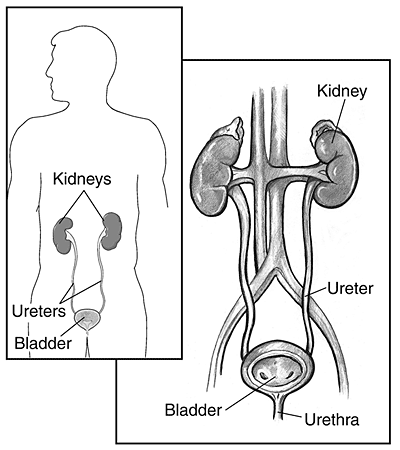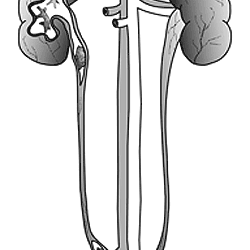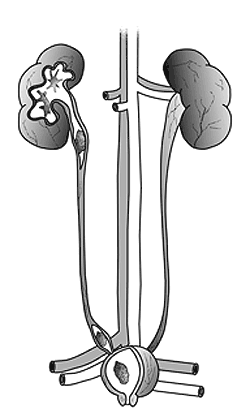Finding out what a kidney stone is made of can help to determine the underlying cause and guide treatment to prevent further stones forming
Kidney Stone Analysis
A stone can be analysed either after a surgeon has removed it from your urinary tract or if you catch a stone that has come out of your urinary tract when passing urine
A stone filtered from your urine or surgically removed from your urinary tract by a doctor
None
-
How is it used?
Kidney stone analysis is performed to determine the chemical composition of a stone after it has been filtered out of the urine or removed from the urinary tract. A laboratory will typically note the physical characteristics of a stone – its size, shape, weight, colour and texture. Sometimes, a picture of the stone will be taken to document its size and appearance. The stone may also be broken so that its layers can be seen. One or more tests will then be performed on crushed fragments to determine the stone's composition.
Blood, urine, and 24-hour urine tests are often requested when a person has a suspected kidney stone. They are performed to detect an underlying cause for stone formation such as excess chemical substances being produced and excreted in the urine. Testing may include:
- Blood and 24-hour urine tests for calcium, uric acid, creatinine, and sometimes oxalate, citrate, phosphate, sodium, urea and cystine
- Urinalysis - to detect red and white blood cells, crystals, signs of infection, and to measure urine pH
- Full Blood Count (FBC) - to evaluate white blood cells for signs of infection
-
When is it requested?
Kidney stone analysis is requested when a person has passed a kidney stone and it has been filtered out of the urine or when a stone has been removed surgically from some part of the urinary tract.
Signs and symptoms associated with a kidney stone may lead a doctor to search for a stone either in urine or within the body using X-rays or scans. A doctor may suspect the presence of a stone when someone has:
When a person has recurrent stones, the first stone found is often tested. Subsequent stones would be analysed only if the doctor deems necessary.
- Severe pain in the side of the back that may move to the groin; pain is the commonest symptom of a kidney stone
- Abdominal pain
- Nausea and vomiting
- Bloody and/or cloudy urine
- Frequent urge to urinate
- Fever and chills, when a urinary infection is present
When a person has recurrent stones, the first stone found is often tested. Subsequent stones would be analysed only if the doctor deems necessary.
-
What does the test result mean?
The chemical composition of the stone can usually be identified. This tells the doctor what the stone is made of, but may not give the cause of stone formation. A person may have an underlying disease or condition that causes them to produce and/or excrete an excess of a specific chemical into the urine. They may have concentrated urine indicating that they do not drink enough clear fluids. They may also have acidic or alkaline urine that contributes to the formation of crystals. Preventing kidney stone recurrence depends upon identifying and addressing the cause of stone formation.
- Calcium oxalate or calcium phosphate stones form when there is excess calcium and/or oxalate (or sometimes too little citrate, which normally binds calcium to prevent stones) in the urine. This may be due to:
- Diet - eating too much animal protein, sugar, salt or foods rich in oxalate increases the risk of stone formation by altering the chemical balance of the urine. High salt intake can lead to increased excretion of calcium into the urine.
- An inherited tendency to absorb more than the normal amount of calcium from the diet, causing high urine calcium (hypercalcuria).
- Factors affecting absorption of nutrients, such as inflammatory bowel disease or intestinal surgery - an imbalance in nutrient absorption may result in excess urinary oxalate.
- Too much parathyroid hormone (primary hyperparathyroidism), leading to high blood and urine calcium.
- A variety of metabolic disorders—these may lead to some degree of metabolic acidosis, resulting in high urine calcium excretion.
- Uric acid stones form when the urine is persistently acidic or when there is excess uric acid such as occurs with gout. People with diabetes are more likely to develop uric acid stones.
- Struvite stones form when specific types of bacteria infect the urine and produce ammonia.
- Cystine stones occur in people with a rare inherited disorder in which excess cystine is excreted in the urine.
- Drug-related stones (very rare) form when certain drugs crystalise in the urinary tract, especially if they are taken for a long time or in very high doses.
- Calcium oxalate or calcium phosphate stones form when there is excess calcium and/or oxalate (or sometimes too little citrate, which normally binds calcium to prevent stones) in the urine. This may be due to:
-
Is there anything else I should know?
Not everyone who drinks too little liquid or who has an excess amount of a substance in their urine will form kidney stones. Some stones will form in people for other reasons. Those who have had one kidney stone are at an increased risk of developing further stones.
Several other factors can contribute to the formation or increased risk of kidney stones. Some of these include:
- A family history of kidney stones
- Presence of a urinary tract infection
- Abnormalities in the structure of the kidneys and/or urinary tract; this may disturb the flow of urine so that crystals form; these can grow into stones.
- Kidney disorders such as polycystic kidney disease, a condition characterised by the presence of numerous cysts in the kidney.
-
Do I really have to filter all of my urine for this test?
-
Can I just test my blood or urine instead of the stone?
-
How bad is the pain with kidney stones?
-
If I have had a kidney stone, should I avoid calcium?
You should work with your doctor to determine the best treatment for you. Eating a diet that is naturally rich in calcium rarely causes kidney stones and protects your bones. About half a pint of milk a day or the equivalent in other dairy products, such as yoghurt or cheese, is about right. In some people, a drastic reduction in calcium in the diet can worsen stone formation as well as weaken bones. Reducing the amount of salt in the diet reduces the risk of stones by its effect on calcium excretion and has the added benefit of lowering blood pressure. It is therefore much more beneficial to avoid salt than calcium. Calcium that is taken in the form of supplements that are prescribed or bought from a pharmacy can increase the risk of producing stones. If you are taking such supplements and have had kidney stones, you should discuss this with your doctor.
-
How does the doctor find a stone in my urinary tract?
-
Who performs a kidney stone analysis?
This testing requires specialised equipment and expertise. It is not offered by every laboratory. In most cases, your stone will be sent to a reference laboratory.
-
What can I do to prevent a kidney stone and prevent recurrence?
-
What are some of the specific methods used to analyse kidney stones?





